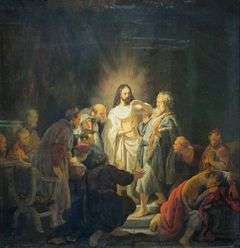John 20:25
John 20:25 is the twenty-fifth verse of the twentieth chapter of the Gospel of John in the New Testament. It contains the reaction of Thomas after the other disciples told him about Jesus' appearance.
| John 20:25 | |
|---|---|
← 20:24 20:26 → | |
 The Incredulity of St Thomas, painting by Rembrandt Harmenszoon van Rijn (1634) | |
| Book | Gospel of John |
| Christian Bible part | New Testament |
Content
The original Koine Greek, according to the Textus Receptus, reads:[1]
- ἔλεγον οὖν αὐτῷ οἱ ἄλλοι μαθηταί Ἑωράκαμεν τὸν κύριον ὁ δὲ εἶπεν αὐτοῖς Ἐὰν μὴ ἴδω ἐν ταῖς χερσὶν αὐτοῦ τὸν τύπον τῶν ἥλων καὶ βάλω τὸν δάκτυλόν μου εἰς τὸν τύπον τῶν ἥλων καὶ βάλω τὴν χεῖρα μου εἰς τὴν πλευρὰν αὐτοῦ οὐ μὴ πιστεύσω
In the King James Version of the Bible it is translated as:
- The other disciples therefore said unto him, We have seen the Lord. But he said unto them, Except I shall see in his hands the print of the nails, and put my finger into the print of the nails, and thrust my hand into his side, I will not believe.
The modern World English Bible translates the passage as:
- The other disciples therefore said to him, "We have seen the Lord!" But he said to them, "Unless I see in his hands the print of the nails, and put my hand into his side, I will not believe."
For a collection of other versions see BibleHub John 20:25
Analysis
The disciples kept telling (Greek imperfect word: elegon, in the sense of "attempted to tell"[2]) their vision of Jesus ("We have seen the Lord"), just like what Mary did in John 20:18.[3]
Thomas has shown his difficulties to understand Jesus in John 11:16 and John 14:15, and this time he hesitated when confronted with the resurrection account.[3] Thomas' emphatic disbelief of the disciples' testimony intensified his resolution to seek physical evidence to convince him that the risen Jesus was the Jesus he had known.[4] This part has a parallel in Luke 24:39.[5]
The palpable marks (Greek: typos) – the 'print of the nails' in Jesus' hands and the pierced hole on his side (John 19:34)[6] – provide 'apologetic function' for the readers of the gospel.[3]
References
- Greek Text Analysis: John 20:25. Biblehub
- Köstenberger, Andreas J. (2004). John. Baker Exegetical Commentary on the New Testament. Volume 4 (illustrated ed.). Baker Academic. p. 576. ISBN 9780801026447.
- Kieffer 2007, p. 998.
- Guthrie 1994, p. 1064.
- Carson, D. A. (1991). The Gospel According to John. Pillar New Testament commentary (reprint ed.). Wm. B. Eerdmans Publishing. p. 658. ISBN 9780851117492.
- Coogan, Michael David (2007). Coogan, Michael David; Brettler, Marc Zvi; Newsom, Carol Ann; Perkins, Pheme (eds.). The New Oxford Annotated Bible with the Apocryphal/Deuterocanonical Books: New Revised Standard Version, Issue 48 (Augmented 3rd ed.). Oxford University Press. p. 180 New Testament. ISBN 9780195288810.
Sources
- Guthrie, Donald (1994). "John". In Carson, D. A.; France, R. T.; Motyer, J. A.; Wenham, G. J. (eds.). New Bible Commentary: 21st Century Edition (4, illustrated, reprint, revised ed.). Inter-Varsity Press. pp. 1021–1065. ISBN 9780851106489.
- Kieffer, René (2007). "60. John". In Barton, John; Muddiman, John (eds.). The Oxford Bible Commentary (first (paperback) ed.). Oxford University Press. pp. 960–1000. ISBN 978-0199277186. Retrieved February 6, 2019.